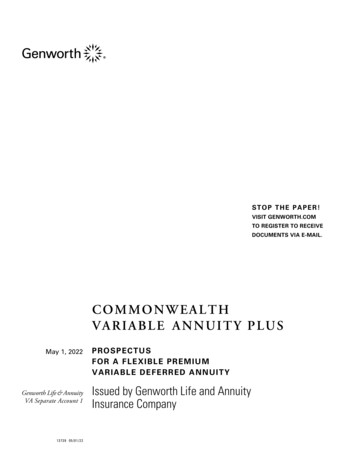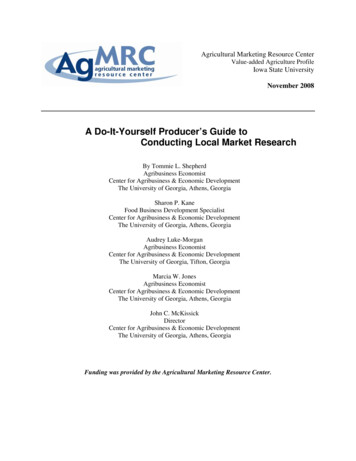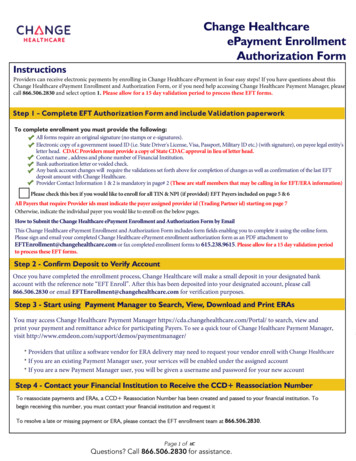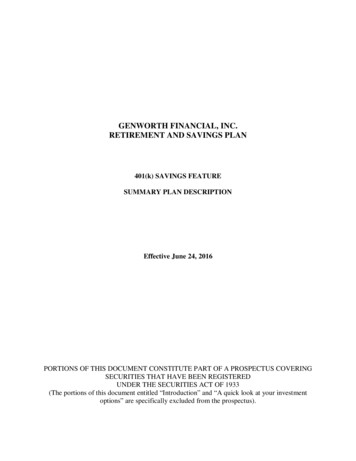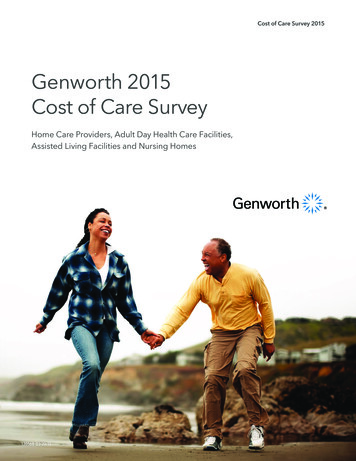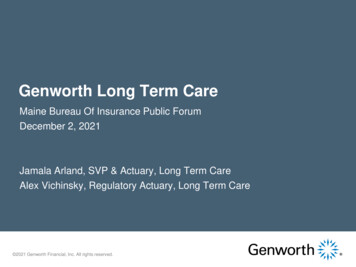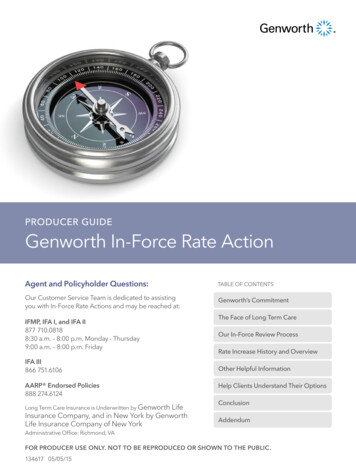
Transcription
PRODUCER GUIDEGenworth In-Force Rate ActionAgent and Policyholder Questions:TABLE OF CONTENTSOur Customer Service Team is dedicated to assistingyou with In-Force Rate Actions and may be reached at:Genworth’s CommitmentIFMP, IFA I, and IFA II877 710.08188:30 a.m. – 8:00 p.m. Monday - Thursday9:00 a.m. – 8:00 p.m. FridayIFA III866 751.6106AARP Endorsed Policies888 274.6124Long Term Care Insurance is Underwritten by Genworth LifeInsurance Company, and in New York by GenworthLife Insurance Company of New YorkThe Face of Long Term CareOur In-Force Review ProcessRate Increase History and OverviewOther Helpful InformationHelp Clients Understand Their OptionsConclusionAddendumAdministrative Office: Richmond, VAFOR PRODUCER USE ONLY. NOT TO BE REPRODUCED OR SHOWN TO THE PUBLIC.134617 05/05/15
HOMEGenworth’s CommitmentGenworth is committed to providing long term careinsurance to help individuals and families plan for thecare they may one day need.In fact, Genworth has provided long term care insurance for more than40 years, protecting over 1.2 million Americans.1 Our decades ofexperience give us significant and unique insights into the challengesrelated to providing long term care services to our aging population. Infact, Genworth insures nearly 25% of all consumers who own anindividual long term care insurance policy.21Genworth internal data, as of December 31, 2014. Represents combined data for Genworth LifeInsurance Company and affiliates including Genworth Life Insurance Company of New York.22013 LIMRA Individual Long Term Care Report, based on Genworth Companies’ share of in-forcelives.1
HOMEThe Face of Long Term CareWith the aging baby boomer population in this country totaling nearly 80million1, long term care has become an increasingly important issue.As Americans live longer, millions may facethe prospect of needing or providing longterm care. In fact, at least 70% of people over65 will need long term care services andsupport at some point.2In reviewing the past five years of survey results,Genworth identified several emerging trends.Overall, the cost of care among facility-basedproviders has steadily increased. The nationalmedian daily rate for a private nursing homeroom is 250 in 2015. This is a 4.17% increaseover 2014 and represents a five year annualgrowth rate of 3.95%.3Unfortunately, as the number of Americansneeding long term care has increased, sohas the cost of the services they require. For12 consecutive years, Genworth has surveyedlong term care service providers across thecountry. The Genworth Cost of Care Surveyis the most comprehensive of its kind,covering nearly 15,000 long term careproviders across 440 regions nationwide.12014 Pew Research Center, Pew Research U.S. Population Projections: 2005-2050, February 2008.22015 Medicare & You, National Medicare Handbook, Centers for Medicare and Medicaid Services, September 2014.32015 Genworth Cost of Care Study2
HOMEOur In-Force Review ProcessIn conjunction with this ongoing review process,Genworth has adopted a more proactive strategyin managing our long term care business. First,we will continue to work closely with regulators toimplement rate increases on certain older blocksof long term care business in an attempt to bringthese blocks closer to break even going forward.Second, we will continue to evaluate theexperience of our newer blocks of long term careinsurance business. If the actual or projectedexperience warrants, we will seek a premium rateincrease earlier in the product lifecycle. And third,we will continue to leverage our more than 40years of experience to develop new products thatare both innovative and incorporate our mostcurrent pricing assumptions.Our actuaries lead a team to perform in-depthreview of our in-force long term care insurancebusiness. This cross-functional team identifiesdevelopments affecting our business andindustry by conducting a detailed analysis ofmorbidity, mortality, and policy terminationtrends.We evaluate our actual and projectedpolicyholder experience and compare it tothe results expected when the product waspriced. These ongoing reviews influence howwe manage our in-force business and how weprice new products.Our FindingsWe continue to see higher than expected persistency among the older blocks of ourin-force long term care insurance products. While this demonstrates that policyholdersvalue their coverage, it is one of our pricing challenges. Because more people thanexpected are retaining coverage, we are seeing a higher number of claims thanexpected when the product was priced. Prior rate increases partially mitigated theseimpacts. We have adjusted for this persistence with our newer products, priced withupdated lapse rates assumptions of 1% or less.3
HOMERate Increase History and OverviewGenworth seeks premium rate increases only after careful consideration. Ourintent is to ensure our business remains strong for years to come, so we candeliver on the promises we have made to our policyholders and partners.During IFA II we applied larger increases topolicies with lifetime benefit periods. Amongother things, this is because lifetime benefits cancorrelate to longer claim durations. The averageclaim on a policy with lifetime benefits lasts 45%longer than the average limited duration policyclaim.1 Lifetime policies represent a greater, lesspredictable risk because the maximum benefit isuncapped.To achieve this goal, we will continue to comparethe actual and projected experience of ourin-force long term care insurance productsagainst the assumptions used when webrought the products to market.In-Force Management Project (IFMP)In 2007, after identifying a higher than anticipatedpersistency rate, Genworth implemented a rateincrease of 8 to 12% on 3-Day, Pre-PCS, PCS Iand PCS II policies.In-Force Rate Action III (IFA III)In the third quarter of 2013, Genworth beganfiling rate increases on Privileged Choiceand Classic Select policies. Our intent is tointervene earlier in the life of the productsto avoid larger increases in the future andprovide greater transparency to ourpolicyholders and distribution partners.In-Force Rate Action I (IFA I)In 2010, Genworth applied an 18% increaseon PCS I and PCS II policies.In-Force Rate Action II (IFA II)In 2012, Genworth applied rate increases onPre-PCS, PCS I, PCS II and Choice I policies.1Source: Genworth Reimbursement Claims Experience through 12/31/13.4
HOMERequested Increases by Product and Benefit PeriodThe table below shows the increases Genworth has requested by product and benefit period.In certain states, the requested amounts may vary due to regulatory requirements.Please Note Previous rate increase requests may not have been approved in all states. If past requestswere not fully approved in states, subsequent rate increase requests will be larger thanreflected in the table. The actual amount of approved and implemented premium rate increases varies by state.Policy SeriesRequested Rate Increase Amount(Years Sold)(Year Increase Requested)IFMPIFA I(2007)IFA II Limited(2010)(2012 Benefit Period)3-Day(1974 - 1988)8%-Pre-PCS(1988 - 2003)9%-PCS I(1993 - 2005)12%PCS II(1997 - 2005)11%IFA II Lifetime(2012 Benefit Period)-IFA III(2013)-35%88%18%60%95%-18%63%78%-44%60%-Choice I(2001 - 2008)--Classic Select(2003 - 2013)----5% - 12.8%Privileged Choice(2003 - 2013)----5% - 12.8%5
HOMEOther Helpful InformationAlabama Group TrustMoratoriumIncluded in IFMP, IFA I and IFA II are certificatesissued under the Alabama Group Trust. TheAlabama Group Trust, established in 1986 bya Genworth predecessor, sold a series of grouplong term care insurance certificates between1986 and 2000. Although certificates issuedunder the Alabama Group Trust were sold inmany states, these certificates were issuedunder a group master policy issued in Alabama.Products issued under the Alabama GroupTrust include Pre-PCS, PCS I and PCS II.Choice products were not issued under theTrust, except in New Jersey.Our understanding of policyholder behaviorhas deepened considerably since our firstrate increase in 2007. Specifically, very fewpolicyholders lapse their policies in connectionwith a rate increase. This demonstrates thatpolicyholders value their coverage.However, we recognize that policyholders areincreasingly frustrated by the potential lackof transparency into possible future increases.For this reason, Genworth adopted a differentapproach in connection with IFA II, specifically forrate actions requested in 2012.In situations where the state approves the entireamount requested, whether implementedcompletely in the first year or over a multi-yearperiod, we intend to not seek additionalincreases for at least five years from the time astate approves the premium rate increase.Rate Stability and Loss RatioRegulationsIn the early to mid 2000’s, most states adoptedthe NAIC model regulation legislation called“Rate Stability.” Rate Stability governs how andwhen insurance companies file for rate increasesand price long term care insurance products.We believe this approach allows our policyholders to plan and gives them the time andinformation necessary to understand and fullyconsider options.“Loss Ratio” is the standard approach for filingrate increase requests for policies sold beforethe adoption of Rate Stability.Please NoteThe five-year moratorium only appliesto IFA II. The moratorium does not applyto IFA III.Certain states have either not adopted RateStability or adopted a modified version. Inthese states, the rate increase requests may bedifferent from the requests made in states thathave adopted Rate Stability.6
HOMEExceptions and VariationsPolicyholders Currently on ClaimPolicies Not AffectedPolicyholders will receive notification of a rateincrease at least 60 days prior to their policyanniversary date. If a policyholder is currentlyon claim and the policy provides a Waiverof Premium benefit, the policyholder is notrequired to pay the increased premiumuntil the benefit no longer applies. Oncethe policyholder comes off of claim, thepolicyholder will be responsible for futurepremium payments as they become due.The following policies have not to date beenaffected by a premium rate increase: Privileged Choice Flex Privileged Choice Flex 2 Privileged Choice Flex 3 Cornerstone AdvantageSM My Future, My PlanSM Long Term Care Business Solutions7
HOMECommunication TimelineWe recognize the impact rate actions have on our policyholdersand distribution partners, and we are committed to providingdedicated support throughout the process. As states approverequested rate increases, we communicate by:1Notifying distribution partners of the percentageincreases through the bulletin process.2Providing agents with a list of all affected policyholders.Please see Addendum #3. The list will be sent prior toany policyholder communications, giving agents anopportunity to proactively contact their clients. The listsare available to the servicing agent on the IFA ResourcesSection of Genworth PRO.3Mailing initial notices to impacted policyholders at least60 days before their anniversary billing dates. Theindividual policyholder notification letters are availableto the servicing agent on the IFA Resources Section ofGenworth PRO.List Bill PoliciesList Bill policies frequently have common billing dates, butdifferent anniversary dates. Notification will be prior to themember/employee’s anniversary/rate increase effective date.Therefore, policyholder lead times will vary.8Please NoteThe first policyholdermailings begin oneweek followingagent notification.
HOMEHelp Clients Understand Their OptionsPolicyholders will likely have questions as they receive notification of their rateincrease. They will look to their financial professionals to guide them on theappropriate action they should take, if any.We partnered with top financial professionals to learn how to successfully explain these changesto policyholders and help them evaluate their options. Here, we share some of their bestpractices:1Prepare for the ConversationBefore having a conversation with policyholders, take time to review their file and familiarizeyourself with their situation. Perhaps a client purchased the policy as part of an overallfinancial plan. Maybe the experience of a family member or friend encouraged them to seeklong term care coverage. Reminding yourself of your client’s personal story will help guideyour conversations.As you prepare for these conversations, review the tools available in this guide. Severalhelpful tools in the Addendum provide important facts and statistics you may find useful toprepare for your conversation. Here are some examples: The LTC fact sheet (45771C) provides information that suggests a shorter benefit periodmay be an appropriate alternative to lifetime options for certain policyholders.A shorter benefit period may reduce your client’s base premium and the amount ofthe applied rate increase. Cost of Care Information (Addendums #1 and #2) will help you consider whether reducingyour client’s daily benefit or Benefit Inflation Option is an appropriate solution. Compare thecosts of different types of care across different states. Discuss adjusting your client’s benefitsbased on the care they think they’ll need and the area in which they expect to live.Once we send your client a notification letter, we recommend you proactively call and explainthe increase, available options, your recommendation, and how the client might respond toGenworth (see Addendum #4 for a copy of the Sample Policyholder Letter). Meeting inperson is also a good option if time permits, as it will give you an opportunity to further solidifyyour relationship and discuss options.9
HOME2Emphasize the Value of the PolicyMany clients purchase long term care insurance to protect their hard-earned assets from theimpact of an unplanned long term care event. Often, the premiums paid on existing policiesare far less than the premiums for a policy purchased today.Compare the cost of the policy they purchased against the cost of a policy purchased today.For example, the table below shows the premium of a Privileged Choice policy and thepremium ofa Privileged Choice Flex 3 policy available today. Although the Monthly Benefit and policymaximum benefit are the same, the cost of a policy available today is much higher than thecost of a similar policy previously sold.Older Policies can have Considerable ValueDataThen: Privileged ChoiceNow: Privileged Choice Flex 3Policyholder Age5050Monthly Benefit 4,500 4,500Benefit Period3 Years3 YearsUnderwriting ClassMarried, PreferredMarried, PreferredBIO5% Simple5% SimpleElimination Period90 Days90 DaysPolicy Maximum Benefit1 162,000 162,000Annual PremiumS/B 8382 152221Policy values are as of policy issue - Monthly benefit & Policy Maximum Benefit will increase over time due to inflation option.2Current rates as of 01/2015 - LTC policies are guaranteed renewal & premium rates can be changed on a class basis by state.10
HOME3Review Client Options to Adjust BenefitsAlthough policies with increased premiums still provide considerable value in light of thesignificant benefits they provide, some clients may not be in a financial position, or be willing,to pay for the same level of coverage at the new rates. There are several options available toclients who want to maximize the value of their coverage while keeping premiums atapproximately the same level. Many of these options may be used together to balancepolicyholders’ coverage needs with their budgets. Policyholders have 60 days from the dateGenworth receives their benefit change confirmation to return to their original benefits,should they change their minds.Adjustment Option 1: Select a shorter benefit periodOur claims experience shows some interesting statistics:1 42% of total claims last less than 1 year. Of those lasting longer than one year, the average claim is 4 years. Only 15% of claims last longer than 5 years.As shown below, policyholders could consider converting their lifetime benefit period toa reduced benefit period to maintain or even reduce their current premiums.Cost Reduction through Shorter Benefit PeriodsNew Premium(With the rate increase)Today’s AnnualPremium Beforethe Rate IncreaseProductWith LifetimeBenefit PeriodWith ReducedBenefit Period4 Year:44% Rate Increase 2,59212.8% Rate Increase 2,835Choice I 2,570Lifetime:60% Rate Increase 4,112PrivilegedChoice 2.13 4,28612.8% Rate Increase 4,83421Source: Genworth Reimbursement Claims Experience through December 31, 2013.2Issued in 2001. Based on 100 original DBA, 50 day EP, lifetime benefit period, 5% compound.3Issued in 2009. Based on 3000 original monthly benefit amount, 30 day EP, lifetime benefit period, 5% compound.11
HOMEAdjustment Option 2: Select reduced benefit amountsCost Reduction through Reduced Benefit AmountsProductChoice I1PrivilegedChoice 2.12New Premium(With the rate increase)Today’s AnnualPremium Beforethe Rate IncreaseOriginal DBA3 of 100Reduced OriginalDBA to 80 2,570Current DBA 180 4,112Current DBA 144 3,290 4,286Current MonthlyBenefit Amount 3,646 4,834Current MonthlyBenefit Amount 2,917 3,867Issued in 2001. Based on 100 original DBA, 50 day EP, lifetime benefit period, 5% compound.Issued in 2009. Based on 3000 original monthly benefit amount, 30 day EP, lifetime benefit period, 5% compound.3DBA is Daily Benefit Amount.12Before changing coverage, consider the potential impactsBy reducing the maximum daily, monthly benefit, or benefit period, clients also will reducetheir lifetime maximum. Policyholders have 60 days from the date Genworth receives theirbenefit change confirmation to return to their original benefits, should they change theirminds. Once that 60 day period expires, benefits cannot be increased or changed back tothe benefits originally selected. Also, if a policyholder was previously on claim, it may not beappropriate to adjust his or her daily benefit.Consider Partnership eligibility requirements before reducing benefitsIn Partnership states, reducing benefits below a certain amount may jeopardize Partnershipstatus and asset protection. In the four original Partnership states of California, New York,Indiana and Connecticut, our administrative system prevents the adjustment of benefitsbelow partnership minimum requirements. If a policyholder wishes to decrease benefitsbelow Partnership minimums in the four original Partnership states, the policy will beconverted to the non-Partnership policy form available at the time of original policy issue.Although benefit reductions are allowed in all Partnership states, the policyholder is requiredto sign a waiver of acknowledgement before reducing benefits.12
HOMEOriginal Partnership statesCalifornia, New York, Indiana and Connecticut require certain minimum daily/monthlybenefits and an inflation option to maintain Partnership status.Eligibility Requirements to Maintain Partnership - Original StatesStateInflationMinimum Daily/Monthly BenefitCA 5% Compound up to age 70 Simple after age 70Determined annually by StateCT 5% Compound up to age 70 Ages 65 , 5% Compoundincreases daily benefit only,maximum does not increaseDetermined annually by StateIN 5% Compound up to age 70 Simple after age 75Determined annually by StateNY 5% Compoundup to age 80Determined annually by StatePartnership Expansion statesThe Deficit Reduction Omnibus Reconciliation Act of 2005, signed into law on February 8,2006, encouraged the expansion of Long Term Care Partnership programs to new states.Currently, there are 351 states with Partnership programs affected by the rate increase. Inthese states, reducing the daily benefit generally does not affect Partnership status. However,changing the inflation protection benefit will likely impact Partnership eligibility.Partnership Expansion state impacted by rate increase - AL, AZ, AR, CO, FL, GA, ID, IA, KS, KY, LA, ME, MD, MN, MO, MT,NE, NV, NH, NJ, NC, ND, OH, OK, OR, PA, RI, SC, SD, TN, TX, VA, WI, WV, WY113
HOMERequirements to Maintain Partnership1 - Expansion StatesStateInflationMinimum Daily/Monthly BenefitSD Ages 18 - 60, Compound inflation Ages 61 - 75, Some form of eitherSimple or Compound Ages 75 , No inflation required 100/dayAll Ages 18 - 60, Compound inflation Ages 61 - 75, Some form of eitherSimple or Compound Ages 75 , No inflation requiredN/AIn both the original and expansion Partnership states, if the policyholder decreases benefitsbelow Partnership minimum requirements, the policy will convert to non-Partnership status.In the original Partnership states, a new policy form will be issued. In both Partnership andPartnership Expansion states, benefit reductions are permitted. However, the policyholdermust sign a waiver of acknowledgement. Only reductions to daily/monthly benefits andinflation require a waiver. Partnership policyholders may reduce maximum benefits payableand/or increase elimination periods without affecting the policies’ Partnership status.1Please note: Many states have adopted their own interest rate requirements for Partnership.14
HOMEAdjustment Option 3: Select a longer elimination periodIf the policyholder doesn’t mind spending more out-of-pocket for the first few months ofreceiving long term care, lengthening the elimination period can also help controlpremiums. Additional out-of-pocket costs based on a longer elimination period may be lessthan the total cost resulting from the rate increase.Adjustment Option 4: Select an inflation option that grows more slowlyThe cost of long term care has increased in the past by as much as 5% per year. This amountvaries by the type of care selected and the region in which care is received (see Addendum:#1 Cost of Care Increases by Care Type for more information). However, one way to reducepremiums is to select an inflation option that grows more slowly.Consider converting policies with a 5% compound inflation option to a 5% simple inflationoption (in states permitting this option) to reduce the effect of premium increases.When considering this option, remember when a reduction in inflation protection isprocessed, the current benefit amount is recalculated from the original effective date ofthe policy or certificate based on the new inflation protection selected.Cost Reduction through Reduced Inflation ProtectionProductToday’s AnnualPremium Beforethe Rate IncreaseChoice I1PrivilegedChoice 2.12New Premium(With the rate increase)With 5%Compound InflationWith 5%Simple Inflation 2,57060% Rate Increase 4,11260% Rate Increase 2,380 4,28612.8% Rate Increase 4,83412.8% Rate Increase 3,9691Issued in 2001. Based on 100 original DBA, 50 day EP, lifetime benefit period, 5% compound.2Issued in 2009. Based on 3000 original monthly benefit amount, 30 day EP, lifetime benefit period, 5% compound.Ideally, a client’s daily benefit maximum should be close to the cost of care in their area(see Addendum: #2 Cost of Care by State for more information). If they moved to a regionwhere the cost of care is lower or plan to move in the future, this may be an appropriatealternative to reduce premiums.15
HOMEAdjustment Option 5: Consider a non-forfeiture optionIf policyholders have reviewed the other options, but found that none suit their needs, thereis no reason to lose the existing value of the policy. Before cancelling any policy, financialprofessionals should tell their clients about the non-forfeiture options available. Non-Forfeiture OptionIf a policyholder elected the optional Non-Forfeiture Benefit at the time of policy purchaseand their policy lapses after this benefit has been in force for the contractually requiredperiod of time, they will receive a limited benefit. Generally, this benefit provides a reduced,paid-up pool of money equal to the total of all the premiums paid or an amount equalto one month (30 days) of the Nursing Facility benefit at the time their coverage lapses,whichever amount is greater. Contingent Non-Forfeiture EndorsementA Contingent Non-Forfeiture benefit allows the policyholder to have a paid-up long term careinsurance policy with benefits equal to the greater of 30 days of the daily benefit or the totalof premiums paid. The Contingent Non-Forfeiture Option is available for 120 days followingtheir increased premium due date. If a policyholder lapses the policy any time during this 120day period, we will assume they have chosen to exercise this endorsement. Limited Non-Forfeiture Option and Optional Limited BenefitAn Optional Limited Benefit, if exercised, allows the policyholder to have a paid-up long termcare insurance policy with benefits equal to the total premium paid, excluding any waivedpremium, less any claims paid. The Optional Limited benefit Option is available to customersfor 120 days after the Billing Anniversary Date on which the rate increase is effective.As this option could significantly reduce the policy benefits, we encourage policyholdersto keep or reduce existing coverage, rather than elect the Optional Limited BenefitOption. A policy lapse at any time within the 120 days following the increased premiumdue date will be deemed as the election of this benefit.16
HOMEConclusionThroughout this period of change, one factremains true: the consumer need for long termcare insurance is stronger than ever. That’s why weare providing many options for policyholders tomaintain their coverage as rates increase. Wecontinue to make tough but smart decisionsdesigned to give our policyholders transparencyinto rate increases, coverage options and greaterpredictability of premiums.Our distribution partners can continue to rely onus to bring industry-leading long term careplanning solutions to market. We are committedto providing a balance of value for our distributionpartners, our clients and for Genworth. Ourultimate goal is to meet the evolving needs oftoday’s consumers and, most importantly, to bethere when policyholders need us most — at thetime of claim.Ask Us For HelpIf you have questions orwould like to run quotes foryour clients, please call us.We’re happy to help youexplain the situation to yourclients, and help you walkthem through their options.Our Customer ServiceTeam can be reached at:IFMP, IFA I and IFA II877 710.08188:30 a.m. - 8:00 p.m.Monday - Thursday9:00 a.m. - 8:00 p.m.FridayIFA III866 751.6106AARP Endorsed888 274.612417
HOMEAddendum #1Cost of Care Increases by Care TypeMINIMUMHomemakerServicesRATE RANGEMEDIANMAXIMUMMEDIANANNUAL RATE1FIVE-YEARANNUALGROWTH2 8 20 40 44,6162% 8 20 40 45,7601% 10 69 242 17,9043% 600 3,600 11,250 43,2002% 90 220 1,255 80,3004% 101 250 1,255 91,2504%HOMEHourly RatesHome HealthAide ServicesCOMMUNITYHourly RatesAdult DayHealth CareDaily RatesAssistedLiving Facility(One Bedroom –Single Occupancy)FACILITYMonthly RatesNursing Home(Semi-PrivateRoom)Daily RatesNursing Home(Private Room)Daily Rates1Percentage increase represents the compound annual growth rate for surveys conducted from 2009 to 2014.18
WA 54,08819CANV 48,048AK 59,488 51,480OR 49,764Addendum #2AZ 45,760UT 48,048ID 43,769HI 54,912NM 43,426CO 49,718WY 46,561MT 52,624TX 42,328OKMOLAAL 36,608TN 40,704KYGAFL 41,184SCDC 45,760NJ 46,332MD 44,616DE 45,760RI 53,768CT 45,760MA 54,340NH 52,899ME 50,336Numbers exclude Puerto RicoNC 40,040VA 41,184PA 41,184WVNY 48,048VT 48,048 46,790 36,608 41,184OH 43,564 43,426IN 43,472MI 45,485USA 44,616MS 36,608 34,320ARIL 48,048WI 48,048 38,896 43,472IA 51,343MN 53,768 43,426KS 43,426NE 50,222SD 49,764ND 59,854Home Care: Homemaker Services Median Annual CostHOME
WA 54,91220CANV 49,489AK 59,488 52,624OR 51,480Addendum #2AZ 45,760UT 48,048ID 46,332HI 56,056NM 46,057CO 50,336WY 49,421MT 52,624TX 42,603OK 46,561KS 45,760NE 52,624SD 52,006ND 62,142LAAL 37,752TN 41,184KYGAFL 43,472SCDC 50,336NJ 48,506MD 45,760DE 50,336RI 56,925CT 50,336MA 57,200NH 54,912ME 50,794Numbers exclude Puerto RicoNC 41,710VA 43,472PA 47,911NYVT 50,336 52,624 42,328WV 36,608 41,184OH 45,348 43,907IN 44,616MI 46,904USA 45,760MS 37,752 36,608ARIL 49,192WI 50,336 38,896MO 43,472IA 52,624MN 57,200Home Care: Home Health Aide Services Median Annual CostHOME
WA 17,56321CANV 18,070AK 31,829 20,020OR 23,010Addendum #2AZ 20,800UT 23,140ID 30,225HI 17,225NM 25,618CO 16,900WY 13,000MT 24,765KSTX 9,100OK 15,600 20,800NE 14,560SD 18,720ND 19,562LA 16,250ARAL 9,425TN 16,120KYGANYFL 16,900SCDC 25,740NJ 22,165MD 20,540DE 17,995RI 17,290CT 20,150MA 16,900NH 16,900ME 28,080Numbers exclude Puerto RicoNC 13,260VA 16,900PAVT 32,136 22,100 15,600 14,381WV 18,720 15,600OH 14,300 17,430IN 20,800MI 20,800USA 17,904MS 9,100IL 17,550WI 16,900 20,800MO 20,795IA 15,600MN 20,267Community Care: Adult Day Health Care Median Annual CostHOME
22CANV 38,850AK 68,430 45,000OR 46,560WA 55,500AZ 41,010UT 36,000ID 38,880HI 48,000NM 42,000CO 45,000WY 46,800MT 42,720TX 42,540OK 40,140KS 50,250NE 43,530SD 36,276ND 38,865LAAL 36,900TN 40,740KYGANY 49,200FL 37,800SCRI 63,900CT 66,900MA 63,600NH 61,230DC 94,050NJ 68,700MD 46,800DE 68,940VTMENumbers exclude Puerto RicoNC 36,000VA 47,196PA 42,660 37,500WV 42,000 34,560OH 46,680 40,200IN 44,310MI 39,000USA 43,200MS 37,800 36,120ARIL 48,600WI 47,760 36,750MO 30,300IA 42,000MN 41,613 48,240 57,600Facility Care: Assisted Living Facility (One Bedroom — Single Occupancy) Median Annual CostAddendum #2HOME
WA 96,93323CANV 86,140AK 281,415 89,396OR 95,904Addendum #2AZ 70,080UT 63,875ID 83,220HI 124,830NM 74,643CO 83,950WY 80,300MT 76,650TX 51,100OK 53,290KS 60,225NE 71,785SD 72,770ND 100,375LAAL 69,715TN 70,080KYGAFL 87,600SCRI 93,075CT 146,000MA 128,845NH 115,340DC 98,550NJ 116,800MD 101,379DE 109,500VTME 100,375Numbers exclude Puerto RicoNC 75,190VA 80,483PA 69,350WVNY 131,758 105,485 102,748 66,795OH 76,650 75,920IN 78,475MI 90,703USA 80,300MS 74,825 56,575ARIL 64,788WI 90,064 56,575MO 55,663IA 63,875MN 84,406 102,018Facility Care: Nursing Home (Semi-Private Room) Median Annual CostHOME
W
The Genworth Cost of Care Survey is the most comprehensive of its kind, covering nearly 15,000 long term care providers across 440 regions nationwide. . room is 250 in 2015. This is a 4.17% increase over 2014 and represents a five year annual growth rate of 3.95%. 3


